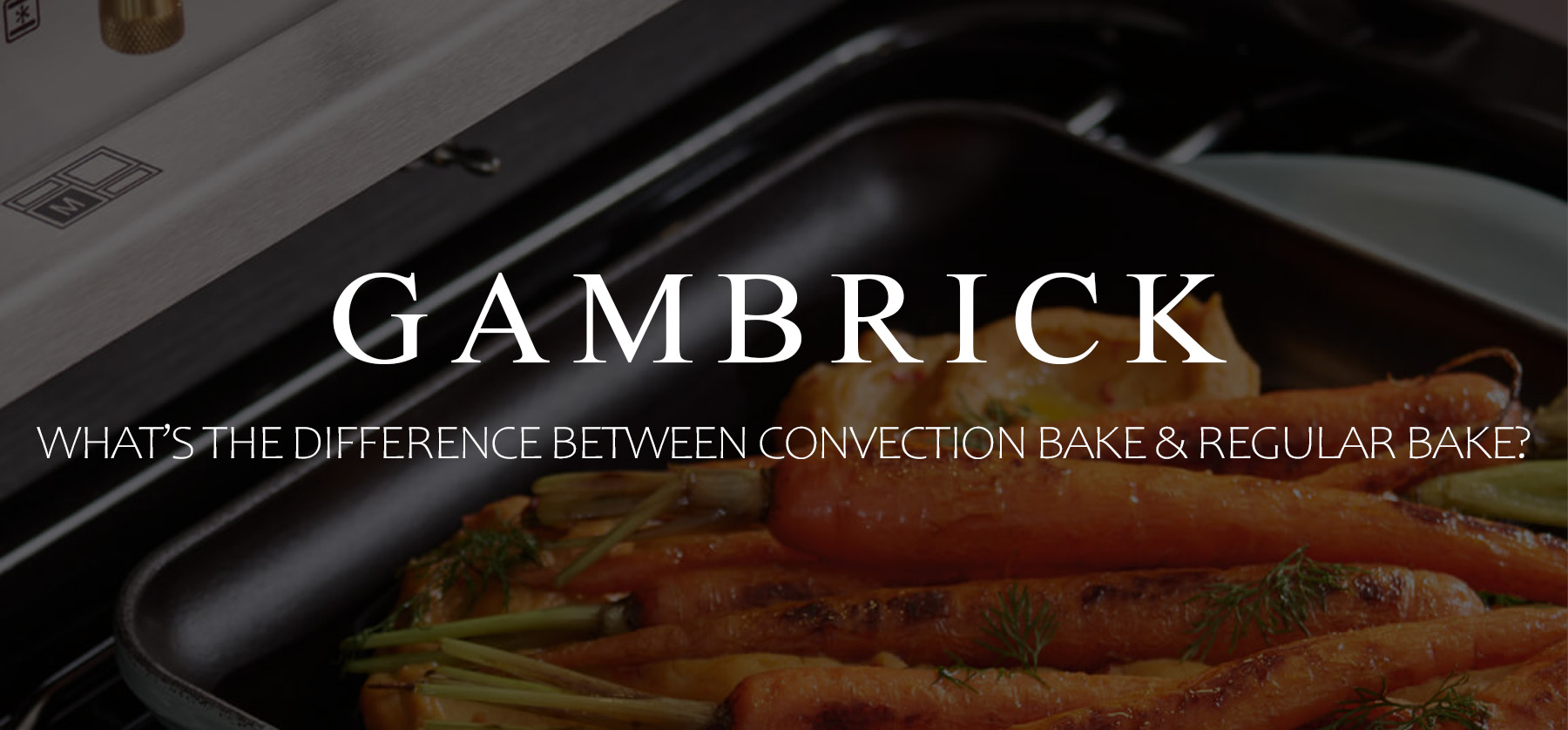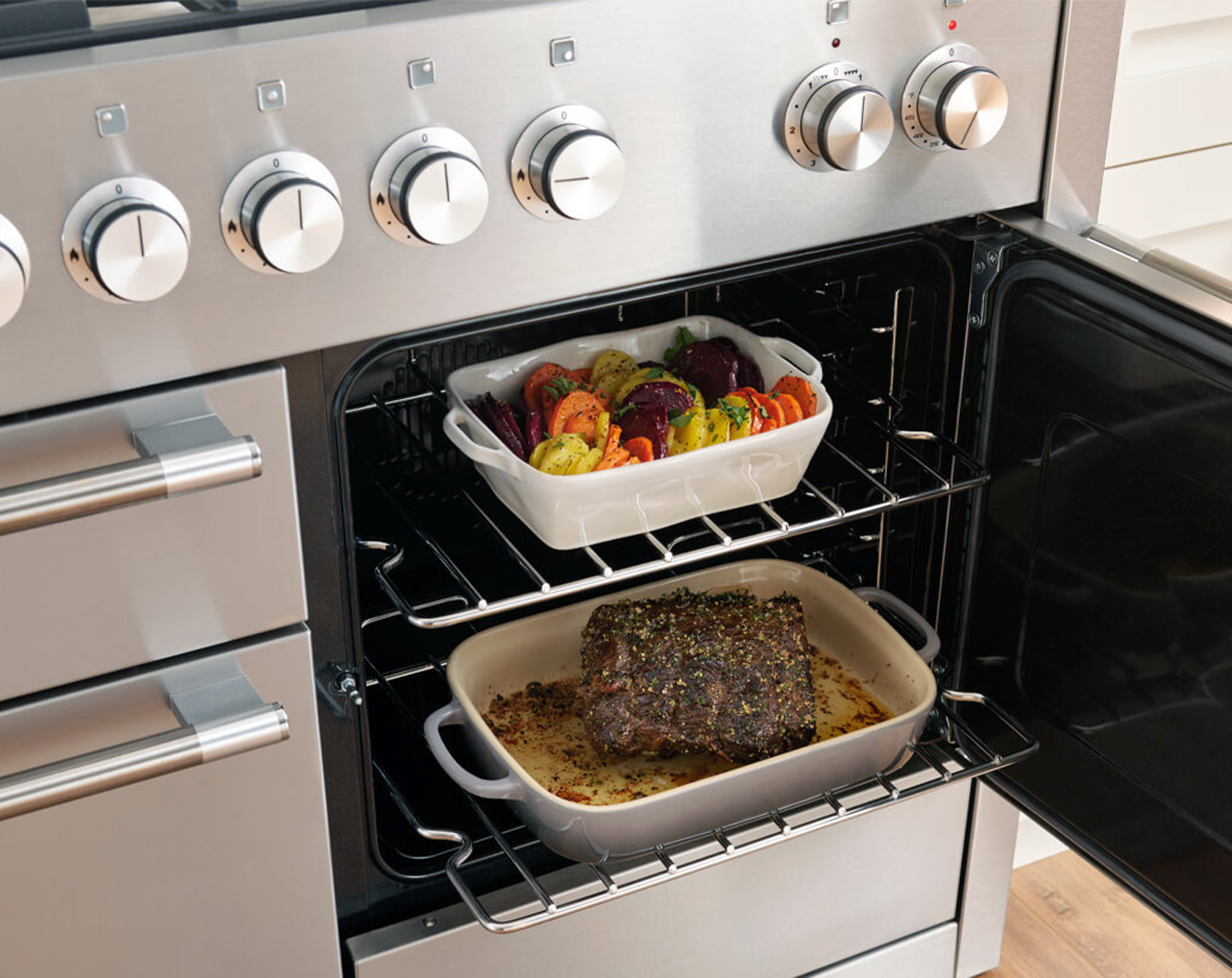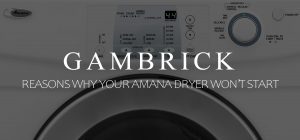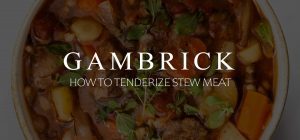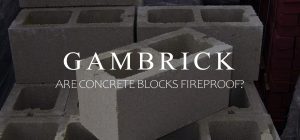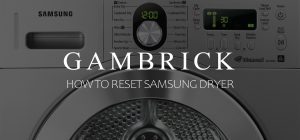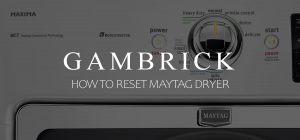What’s The Difference Between Convection Bake And Regular Bake?
The main difference between Bake and Convection Bake is how heat is distributed during cooking and the type of heat used. Convection Bake uses an air circulation system that evenly distributes hot air inside the oven cavity. On the other hand, a conventional oven using Regular Bake relies on two heating elements to heat the air inside the cavity without the use of a fan. Because of the heating elements used in a traditional oven, Regular Bake is radiant heat, and convection bake is not.
Convection ovens and regular ovens with a convection option are common. What’s the difference between the convection bake vs bake functions? Convection bake uses air circulation for even heat distribution, while regular bake relies on heating elements without a fan.
When cooking, convection ovens tend to cook faster, produce crispier and browner skin, and more evenly cooked food. However, they’re not the best choice for some delicate desserts that are affected by blowing air. Convection ovens can also be tricky if you bake lots of things at once because multiple dishes can overcrowd the oven box and block airflow. But this isn’t a problem with radiant-heating ovens.
Some convection ovens may have a third heating element, known as true convection, which works in conjunction with the fan to provide even faster cooking times compared to traditional thermal bake settings.
Understanding the differences between Convection Bake and Regular Bake can help when you’re baking with various ovens. Knowing when to use Convection Bake vs. Regular Bake can help you get the best baking results for a variety of dishes.
What Is Convection Bake?
Convection baking is a cooking method that uses a fan to evenly distribute hot air within the oven. The fan helps maintain consistent temperatures and ensures even cooking across multiple racks. Convection Bake is the oven setting that turns on the fan.
- One of the key benefits of convection baking is that it removes excess moisture from the surface of the food. The result is crispy and evenly browned dishes.
- The circulating hot air evenly cooks the food, which reduces the likelihood of unevenly cooked or undercooked dishes.
- Convection bake can achieve more consistent results, potentially shortening cooking times.
- It’s particularly useful when baking pastries, cookies, and roasts, as it helps create an even temperature throughout the oven.
Convection bake is a cooking method that uses a fan to distribute hot air evenly, resulting in more consistent and evenly cooked food. It’s best used for achieving crispy textures, browning, or baking pastries.
How Do Convection Ovens Work?
Convection ovens use a fan and an exhaust system to circulate hot air throughout the oven cavity. Circulating air helps distribute heat more evenly and efficiently, resulting in faster and more even cooking. Food cooked in a convection oven is generally crispier and more evenly browned, making it great for meat dishes. It’s also fantastic for baking because the temperatures are more evenly distributed around the pastries.
- In most convection ovens, you have the option to turn the convection settings on or off, allowing you to switch between convection and conventional thermal cooking methods as needed.
- Some convection ovens include a third heating element, which enhances cooking speed and performance compared to traditional thermal-bake cycles.
Regular bake cycles in traditional ovens without a convection function operate similarly to conventional thermal ovens. They rely on one or two heating elements without the added air distribution system of convection ovens.
Overall, convection ovens provide more even heat distribution and faster cooking times vs. a traditional baking oven, making them a popular choice for many home and professional cooks.
What Is Convection Bake Used For?
Convection bake is used for recipes that benefit from more even heat distribution. For example, Convection Bake is your best option if you’re baking multiple batches of cookies or cooking dishes on different oven racks simultaneously. It’s also good for cooking meats because the skin will be crispier with more even browning.
- The circulating hot air created by convection baking is really good for roasting. It creates a crispy and flavorful skin on meats while caramelizing your vegetables. The result is better-tasting food with a fantastic texture.
- By using the Convection Bake settings, your food will be cooked more evenly with better browning and a reduced cooking time.
- Convection Bake is best for recipes that need consistent heat distribution and enhanced surface browning. This includes roasting meats and baked goods.
Convection Bake is best for recipes that need even heat distribution and enhanced browning. Because the heat circulates evenly throughout the oven, it’s extremely beneficial for baking multiple batches, roasting meats, and caramelizing vegetables.
Convection Bake Vs. Bake To Cook?
Convection Bake settings create an ideal cooking environment for specific recipes because they bake more evenly. It can be used to cook a wide variety of foods, including meats, vegetables, casseroles, cookies, pies, and more. When you use convection bake, you can achieve light and flaky textures in baked goods and meats with crispier skin.
However, some baked goods are best cooked using conventional oven settings. Delicate desserts and pastries like cakes, quick breads, and custards may not turn out as good when prepared using a Convection Bake oven. I recommend using conventional baking methods for these types of recipes.
Convection Bake settings are a great choice for various recipes. They’re excellent for achieving even baking and can be used for a wide range of foods. But be mindful of the specific requirements of delicate desserts and pastries because they may be better suited for conventional oven settings.
Which Is Better Baking Or Convection Baking?
Convection Bake is best for more even browning, roasting, and baking quickly. Convection bake circulates air, which results in a steady, dry temperature that cooks faster than radiant heating with less hot and cool spots in the oven. This means foods will cook faster with a dryer surface. While this type of heat is great for roasting meat and some desserts, it’s not the best for delicate desserts or fine baking.
Does Convection Bake Take Longer Than Bake?
No, Convection Bake typically cooks faster because the circulating air is more evenly distributed around the food. This heats the food more evenly because there are no hot and cool spots, which cooks the food faster. Generally, food that’s baked in a convection oven cook about 25% faster than food cooked in a traditional oven using radiant heating. To compensate for the faster cook time, you can reduce the time stated on a recipe intended for a traditional oven by 25% or reduce the heat by about 25 degrees Fahrenheit.
Does A Convection Oven Cook Faster?
A convection oven cooks faster and more evenly than a traditional oven. Conventional ovens use radiant heat from heating elements to heat the oven. This can cause variations in cooking times depending on the dish’s placement inside the oven. Generally, the closer you are to the heating elements, the hotter the food will get. This can also cause uneven cooking. In contrast, convection ovens use circulated air to provide consistent heating throughout the oven cavity. This means no hot or cool spots inside the oven and more even baking.
- With convection baking, you can expect reduced hot or cold spots in your dishes. This means your food will cook more evenly without having to rotate dishes or adjust cooking times to compensate for uneven heat distribution, which can be a problem for regular ovens.
- The circulating air in convection ovens helps maintain a consistent temperature and distributes heat more evenly. This results in faster and more reliable cooking. This feature saves you time and ensures your dishes are perfectly cooked.
Convection baking offers the advantage of consistent heating and eliminates the need for frequent dish rotation or adjustments. This means the food cooks faster and more evenly in a convection oven vs. a traditional oven.
Convection ovens allow you to enjoy faster and more evenly cooked meals without worrying about uneven heat distribution.
Is Convection Bake Good For Homemade Recipes?
Convection ovens offer the best environment for preparing various dishes, such as homemade pizza and oven-baked bread, thanks to their even heat distribution. When using convection baking, hot air is evenly delivered to every area of the food, ensuring consistent cooking throughout. Since no hot or cool spots are inside the oven, your food cooks faster and more evenly.
- In traditional ovens, heat is primarily distributed from the bottom heating element, often resulting in a burnt bottom and an undercooked top.
- Convection baking helps achieve a crispier crust by circulating hot air evenly throughout the oven cavity. This improved heat distribution enhances the overall texture and quality of the food.
Convection Bake is great for homemade recipes like baked desserts, pizza, meats, or sourdough bread. The even heat provided by convection baking is more consistent, making cooking easier.
Convection ovens create an optimal cooking environment for a variety of dishes because the heat is evenly distributed throughout the oven. This helps achieve consistent results and opens up exciting possibilities for homemade recipes.
Difference Between Convection Vs. Regular Baking
A convection oven’s fan and exhaust system produce different results than a standard oven. The moving air in a convection oven cooks food faster and at a higher temperature thanks to the extra energy generated by the circulating air. This creates more consistent heat distribution, with no hot and cold spots. The result is more even cooking in less time.
The reduced moisture inside the oven contributes to deeper browning and a crispier exterior on many foods. This is great for meats because the skin becomes crispy and golden brown.
Here are some more differences between convection bake vs. regular bake ovens:
- Reduced Temperatures: Because the air inside a convection bake oven is hotter and the heat is better distributed, many recipes require a lower oven temperature to prevent overcooking vs. baking in a regular oven.
- Faster Cooking: You can usually reduce the cooking time listed in a recipe because the heat is more evenly distributed inside a convection oven.
- Avoid Overcrowding: Convection cooking works best when air can circulate around the food. Try not to block the flow of air by overcrowding the oven with lots of dishes on each rack. Less food inside the oven lets hot air circulate freely around the food. This isn’t as big a problem with a traditional radiant heat oven.
By understanding the differences between a regular and a convection bake oven, you can make adjustments to your recipes. A few small changes to temperature, cook time, and how you position dishes in the oven can maximize the benefits of convection baking, which helps achieve more delicious and evenly cooked meals.
When To Use Convection Bake?
Foods that benefit from increased browning and crispy skin are best when cooked in a convection oven.
Here are some examples of foods that are best baked with a convection setting:
- Cookies: Convection heat helps create a brown and crispy exterior with a soft and moist interior cooky.
- Pies and flaky pastries: More even heat and a drier environment adds flakiness and a more golden exterior.
- Crusty bread: Dry heat helps create a crustier exterior with a more golden color.
- Roasted meats: Convection cooking creates a brown and crispy skin that helps lock in moisture for more tender meat.
When To Use Conventional Bake
While convection baking offers many advantages, certain foods, especially specific baked goods, are better suited for a conventional bake setting.
Here are some examples of foods that are best baked in a conventional setting:
- Cakes: Convection baking can cause ripples in the cake batter, resulting in an uneven surface. Baking in a standard oven ensures a smoother top.
- Quick breads, muffins, and cupcakes: Smaller baked items can be blown sideways by the moving air in a convection oven, leading to uneven tops. Using a conventional bake setting allows the tops to remain stable.
- Soft, yeasted bread: Rolls and sandwich bread with a soft texture are better preserved in the more moist environment provided by a standard oven.
Using a conventional bake setting for these types of foods can achieve better results in terms of texture and appearance. However, some foods like roasted meats and vegetables can still benefit from convection baking.
When Shouldn’t You Use Convection Bake?
You shouldn’t use the convection bake setting for delicate desserts that cook quickly. While the convection setting is excellent for roasting, I’ve found that it’s not the best setting for baking delicate dishes and desserts. The circulating air from the fan can cause issues with moist foods that are prone to shifting or splattering, such as quick breads, custards, and other baked goods. These items may turn out dry and unevenly baked due to the airflow.
In some cases, cookies or cakes may exhibit a “sand drift” pattern caused by the moving air. It’s better to use the regular setting for these types of desserts.
Since these items typically have shorter bake times, the time-saving aspect of the convection setting becomes less beneficial. For more delicate baked goods, I recommend using the regular bake setting if you want moist and evenly baked results.
Does Convection Bake Take Longer Than Bake?
No, convection bake doesn’t take longer than bake. In fact, convection ovens generally cook food faster than conventional ovens because of the circulating hot air. When using a convection oven, you can use a simple formula to adjust the cooking process: either reduce the temperature by 25 degrees Fahrenheit or decrease the cooking time by 25%. This adjustment ensures that your food doesn’t overcook.
Some modern ovens come with convection conversion features, eliminating the need for guesswork. These ovens automatically adjust the temperature and cooking time when you switch to convection mode, which helps eliminate mistakes and overcooking.
Convection bake is usually faster than regular bake because of how the hot air circulates around the food. However, if you overcrowd the oven and block the air, your recipes can take longer to cook. To gain the full benefits of a convection oven, don’t overcrowd the oven with multiple dishes on every rack, and leave space on the sides of your dishes so hot air can flow.
Can You Use Foil In A Convection Oven?
Yes, you can use aluminum foil in a convection oven. Aluminum foil can be safely used in a convection oven to cover dishes, wrap food, or create a tent to prevent excessive browning.
However, it’s important to follow some basic guidelines:
- Don’t block airflow: Avoid completely covering the oven racks with foil because it can restrict airflow inside the oven. Convection ovens work by circulating hot air around the food. If you block the air with foil, your food won’t cook properly.
- Use foil in moderation: Use aluminum foil sparingly and only when necessary. Using too much can disrupt how heat is distributed throughout the oven.
- Secure foil: Make sure the foil is securely fastened to the dish to prevent it from blowing or shifting because of the fan’s airflow. Remember, convection ovens work by circulating air around the food, they don’t use radiant heat like a traditional oven.
Always refer to the manufacturer’s instructions or guidelines for your specific convection oven model. They may provide additional information or recommendations regarding the use of foil in the oven.
Aluminum foil can be used in a convection oven, but it’s important to use it correctly. Avoid blocking airflow and secure it properly to the dish so it doesn’t move around.
What Kind Of Pans Can I Use In A Convection Oven?
You should use bright aluminum, cast iron, or light-colored pans in a convection oven. These types of pans distribute heat more evenly and prevent foods from browning too quickly. Avoid using bakeware with anodized finishes because they can affect browning.
Ceramic dishes, Earthenware, and some glass dishes aren’t as effective at directing heat in a convection oven. If you use these kinds of pans, place them on the bottom element of the oven for better results.
Summary: What’s The Difference Between Convection Bake And Regular Bake?
The main difference between Bake and Convection Bake is how heat is distributed during cooking and the type of heat used. Convection Bake uses an air circulation system that evenly distributes hot air inside the oven cavity. On the other hand, a conventional oven using Regular Bake relies on two heating elements to heat the air inside the cavity without the use of a fan. Because of the heating elements used in a traditional oven, Regular Bake is radiant heat, and convection bake is not.
- When cooking, convection ovens tend to cook faster, produce crispier and browner skin, and more evenly cooked food.
- However, they’re not the best choice for some delicate desserts that are affected by blowing air.
- Convection ovens can also be tricky if you cook lots of things at once because multiple dishes can overcrowd the oven box and block airflow. But this isn’t a problem with radiant-heating ovens.
- Some convection ovens may have a third heating element, known as true convection, which works in conjunction with the fan to provide even faster cooking times compared to traditional thermal bake settings.
Understanding the differences between Convection Bake and Regular Bake can help you get the best baking results for a variety of dishes.
If you have any questions or comments about the differences between Convection Bake and Regular Bake ovens, email any time.
